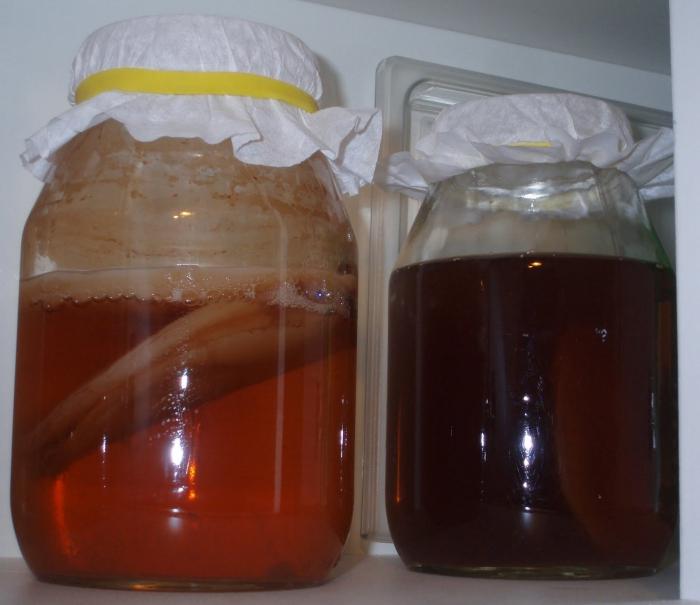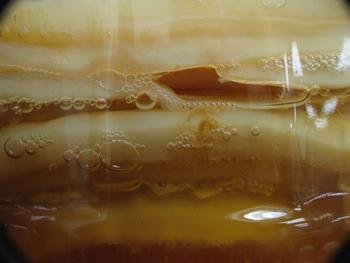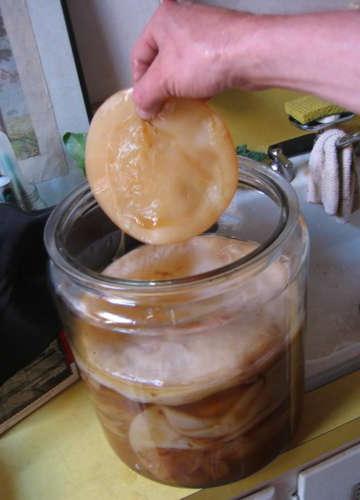Many of us remember how in childhood our grandmother poured sour liquid from a three-liter jar in the summer, in which something like a jellyfish floated. We added sugar to the drink, and it perfectly quenched our thirst. This drink was made before using kombucha, and today I would like to remind you what it is and how it is prepared.

On the Internet, people often ask about where to get kombucha, which the inhabitants of the former USSR say - you can grow it yourself. To do this, add a little sugar to a sufficiently large amount of strong tea leaves and put in a warm place for a month and a half. During this period, an unsightly film is first formed on tea leaves, which then grows into a full-fledged multilayer tea mushroom.
To prepare a drink, take a small plate of mushroom, put in a 3-liter jar and pour cold cold sweetened weak tea (5-6 teaspoons of tea leaves per liter). In the first three days, the bank may not have any reaction, but in a week the mushroom will pop up, and the tea will turn into tea kvass. To improve the characteristics of the drink, honey and aromatic herbs can be added to the topped tea.
In order for Kombucha to develop well and not be sick (it is, after all, a living organism), certain conditions must be observed:

do not keep a can of tea in the light or by the window, as the mushroom does not like the sun's rays and drafts;- Do not cover the jar with a lid - it is better to tie a cloth;
- the optimum temperature for reproducing the drink is about 25 ° C (not lower than 17 ° C!);
- sugar cannot be sprinkled on the mushroom, it must be added only previously dissolved in tea;
- the mushroom should be washed, preferably in spring water, in the summer every two weeks (weekly, if the temperature is not optimal), in the winter - every three to four weeks.
Many centuries ago, warriors of ancient Japan discovered what Kombucha is useful for. It was used as a disinfectant for wounds and suppurations, and helped with disorders of the gastrointestinal tract. And after entering Europe and Russia (during the Russo-Japanese War), other properties were discovered. Kombucha drink helped with tonsillitis, stomatitis, lowered cholesterol, contributed to an increase in lactic acid beneficial bacteria, gave positive results for neurasthenia, poisoning, angina pectoris, poisoning and well supported people with cancer. From it they make drugs - medusins and bacteriocidins.

Chemical analysis of Kombucha infusion revealed the presence of six types of acids, enzymes, caffeine, B vitamins, a large amount of vitamin C and PP group.
However, Kombucha, like many medicinal infusions, has contraindications for use. It is not recommended to be taken by insulin-dependent diabetics, people suffering from fungal diseases (due to the content of sugars in the infusion). You can not drink it with an open stomach ulcer, gastritis. With a drink made on the basis of green tea, you need to be cautious hypotensive. Also, you can not drink overexposed infusions and infusions made on the basis of an old, sick mushroom.
Otherwise, the use of Kombucha is extensive - with it you can make relaxing baths (per bath 0.25 liters of monthly tea kvass), lotions (a mixture of mineral water and monthly tea kvass), deodorants (wipe in sweating areas), hair rinses, cream for flaky skin (with olive oil). It helps a lot in the treatment of colds, as well as from bee stings. Such a "helper" will be indispensable in the economy, especially since growing it will not be difficult.
